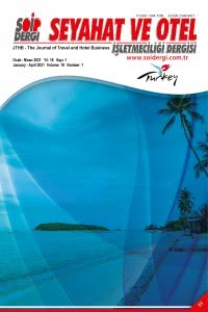Kırsal Turizm Planlaması Kapsamında Gastronomi Etkinliklerinin Değerlendirilmesi
The Evaulation of Gastronomic Events Within the Context of Rural Tourism Planning
___
- Ardabili, F.S., Rasouli, E., Daryani, S.M., Molaie, M. ve Sharegi, B. (2011). „The Role of Food and Culinary Condition in Tourism Industry‟, Middle-East Journal of Scientific Research, 9 (6), ss. 826-833.
- Aref, F ve Gill, S.S. (2009). „Rural Tourism Development through Rural Cooperatives‟, Nature and Science, 7(10).
- Aslan, A.(2008). „Turizm Planlamasına Yerel Toplumun Katılımı: Saklı Bahçe Akyaka Üzerine Bir İnceleme‟, Anatolia: Turizm Araştırmaları Dergisi, 19 (1), ss. 71-83.
- Bahçe, A.S. (2013).Alternatif Turizm, I.baskı, Eskişehir: Anadolu Üniversitesi.
- Deveci, B., Turkmen, S.,ve Avcıkurt, C.(2013). „Kırsal Turizm İle Gastronomi Turizmi İlişkisi: Bigadiç Örneği‟, International Journal of Social and Economic Sciences, 3 (2), ss. 29-34.
- Everett,S ve Aitchison, C. (2008). „The Role of Food Tourism in Sustaining Regional Identity: A Case Study of Cornwall, South West England, Journal of Sustainable Tourism, 16 (2), ss.150-167.
- Hall, C.M., Mitchell, R. ve Sharples,L. (2003), „Consuming places: the role of food, wine and tourism in regional development‟İçinde Hall, C.M., Sharples, L., Mitchell, R., Macionis, Cambourne, B, (Editörler) Food Tourism Around the World:Development, Management And Markets, ss. 25-59, Butterworld Heinemann: Burlington.
- Hall, C.M., Mitchell, R. ve Sharples,L. (2003), „The consumption of experiences or the experience of consumption? An introduction to the tourism of taste‟ İçinde
- Hall, C.M., Sharples, L., Mitchell, R., Macionis, Cambourne, B, (Editörler) Food Tourism Around the World:Development, Management And Markets, ss.1-25, Butterworld Heinemann: Burlington.
- Holloway.J, Humphreys C ve Davidson R.(2009), The Business of Tourism, Edinburgh Gate Harlow Essex CM20 2JE England: Pearson Education Limited.
- Hong, W-C. (1998). Rural Tourism: A Case Study of Regional Planning in Taiwan.(Online),http://fftc.imita.org/htmlarea_file/library/20110726110810/eb456. pdf.Erişim:11.01.14.
- Kalinia, A. (2013). „Branding Sicily as Gastronomically Attractive Destination, Viewed by Kempinski Hotel Giardino di Costanza‟, Saimaa University of Applied Sciences Tourism and Hospitality, Imatra Degree Programme in Tourism.
- Kesici, M. (2012). ‘Kırsal Turizme Olan Talepte Yöresel Yiyecek ve İçecek Kültürünün Rolü‟, os al ve E onomı Araştırmalar Dergısi, 14 (23), ss. 33-37.
- Kiper, T.,ve Özdemir, G. (b.t). „Tourism Planning in Rural Areas and Organization Possibilities‟, Namı emal Universit , Facult of Agriculture, Department of Landscape Architecture, Department of Agricultural Economics.
- Lane, B. (2005). „Sustainable Rural Tourism Strategies: A Tool For Development and Conservation, Interamerican Journal of Environment and Tourism, 1(1).
- Lee, A. (2012). The Creative Food Economy and Culinary Tourism through Place Branding: „TERROIR‟ into a Creative and Environmentally Friendly Taste of Place, Unpublished Doktorate Thesis, University of Waterloo, Ontario, Canada.
- MacDonald, R ve Jolliffe, L. (2003). „Cultural Rural Tourism Evidence From Canada, Annals of Tourism Research, 30 (2), ss. 307–322.
- Hall, C.M., Sharples, E., Mitchell, R., Cambourne, B., & Macionis, N. (2003), Food Tourism Around the World;Development, Management and Markets,1.Ed, Butterworth-Heinemann/Elseiver, Oxford.
- Michela C. M. ve Adriano P. (2009). „Celebrating Local Products: The Role of Food Events‟, Journal of Foodservice Business Research, 12(4),ss. 364-383.
- Matlovicova. K. ve Pompura M. (2013). „The Culinary Tourism in Slovakia: Case Study of the Traditional Local Sheep‟s Milk Products in the Regions of Orava and Liptov‟. GeoJournal of Tourism and Geosites, 2(12),ss.129-144.
- Mihailovic, B.ve Moric, I. (2012 ). „The role of Marketing philosophy in Rural Tourism Development‟. Tourism and Hospitality Management, 18(2), ss. 267-279.
- Okumuş, B., Okumuş, F.,ve McKrecher B. (2007). „Incorporating local and international cuisines in the marketing of tourism destinations: The cases of Hong Kong and Turkey‟. Tourism Management, 28, ss. 253–261.
- Özdemir, G. (2006 ). „Resort Planlaması: Turizm Planlaması İçindeki Yeri ve Önemi‟. Journal of Yaşar Universit , 1(3), ss. 239-253.
- Piebiak, M. (2008). Regional Food Cluster Review, A Federal Provincial Territorial Initiative, Canada: Alberta.
- Rand, G. E. D., Heath, E ve Alberts, N. (2003). ‘The Role of Local and Regional Food in Destination ar eting’, Journal of Travel & Tourism Marketing, 14(3-4), ss. 97-112.
- Soykan, F. (2000). „Turizm Coğrafyası ve Turizm Planlaması‟. Ege Coğraf a Dergisi, 11(2000), ss. 39-55.
- Torun, E.(2013 ). „Kırsal Turizmin Bölge İnsanına Katkıları‟, os al ve E onomı Araştırmalar Dergısi, 15 (24), ss. 31-37.
- Uysal M. ve Baloğlu Ş. (1994). „Destinasyonun Yaşam Süresi İle Taşıma Kapasitesi Arasındaki İlişki‟, Anatolia, ss. 36-42.
- Yozukmaz, N., Ekiztepe, B.A. ve Çeken, H. (2014). „The Importance of Rural Tourism: Rural Tourism Practices in the World and in Turkey‟, International Journal of Social and Economic Sciences, 4 (2), ss. 37- 44.
- Yıldırım, A.ve Şimşek, H. (2011). Sosyal Bilimlerde Nitel Araştırma Yöntemleri, Ankara: Seçkin Yayıncılık.
- ISSN: 1304-7590
- Yayın Aralığı: Yılda 3 Sayı
- Başlangıç: 2004
- Yayıncı: Sidas Medya Ajans Tanıtım Danışmanlık Ltd. Şti.
Yerleşik Yabancıların Türkiye Turizmine Etkileri: Marmaris İlçesi Örneği
Gizem ÖZGÜREL, Cevdet AVCIKURT
YERLEŞİK YABANCILARIN TURİZME ETKİLERİ: MARMARİS İLÇESİ ÖRNEĞİ
Gizem ÖZGÜREL, Cevdet AVCIKURT
Staj Yapan Öğrencilere Yönelik Cinsel Taciz: Otel İşletmeleri Örneği
Kamil UNUR, Sabahat Ceylin ŞANLI
Kapadokya’yı Ziyaret Eden Yabancı Turistlerin Yiyeceklere Karşı Çeşitlilik Arayışlarının İncelenmesi
Seda DERİNALP ÇANAKÇI, KEMAL BİRDİR
Kırsal Turizm Planlaması Kapsamında Gastronomi Etkinliklerinin Değerlendirilmesi
Aynur GÜLENÇ BİRSEN, ABDURRAHMAN DİNÇ
Kırsal Turizm Planlaması Kapsamında Gastronomi Turizminin Değerlendirilmesi
Aynur GÜLENÇ BİRSEN, Abdurrahman DİNÇ
TURİZM SEKTÖRÜ YÖNETİCİLERİNİN ALDIKLARI LİSANSÜSTÜ EĞİTİME YÖNELİK ALGILARI
